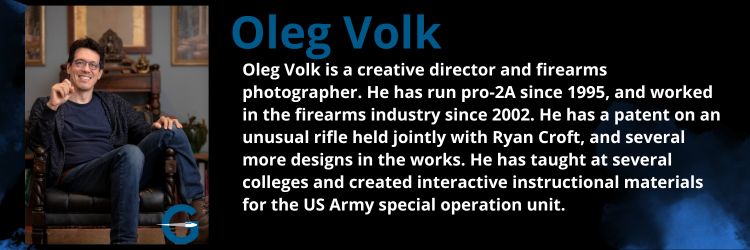
How to Zero in Your Optics
Ever since the range of guns expanded past a few steps and the accuracy improved enough to warrant sights, they developed very fast. The first serious use of handheld firearms dates back to the Hussite wars of the early 1400s, and adjustable notch and post sights appear shortly thereafter. By the early 1500s, the most advanced arquebuses had both rifling and range-adjustable rear leaf sights.
The idea behind sights in general is to correlate the point of aim with the point of impact. A projectile in ballistic flight is affected by gravity and air resistance: the result is a parabolic path that’s quite predictable given consistent bullet form, weight, and velocity. On the simplest level, zeroing means that a gun could be fixed in position and fired at a target several times, then the sights would be adjusted horizontally (windage) and vertically (elevation) to point at the center of the resulting shot group. That would give an extremely close prediction of where the next shot would land at the same distance, with the same ammunition, and under identical atmospheric conditions. Changing anything, including un-strapping the gun and firing it freehand, would change the point of impact relative to the sight picture.
The Importance of Zeroing-In
On the simplest practical level, the sights are adjusted once for “point-blank” range. Point-blank just means that aiming at the center of the target would produce a hit somewhere on that target anywhere from the muzzle to a known range. Heavier and faster bullets used against large targets, like those fired from 50BMG against vehicles, may have a point-blank distance of half a mile. Lighter and smaller bullets shot at small targets like 22CB caps shot at garden pests, may have a point-blank range of twenty yards. As the requirements for precision and distances increase, so does the need for finely adjustable sights. However, no matter how precisely and repeatedly adjustable a sight may be, it has to be zeroed first because all changes are done relative to this initial reference point. Many hunters don’t want to deal with the hassle, so they have the gunsmith zero rifles for them.
A rough zero may be obtained without live fire by using a laser bore sighter. This is enough for a fairly precise windage adjustment but only less precise for an elevation adjustment, as the bullet path is curved while the laser path is straight. The most important step is to determine the distance for the zero. The line of sight through irons or scope is straight, while the bullet path is curved. The barrel is aimed up relative to the sights, so that the bullet should cross the line of sight twice, the first distance being “close zero” on the projectile’s way up, the second being “far zero” on the bullet’s way down.
In many instances, the scope bullet drop compensating (BDC) reticle is marked on the assumption of a specific load, height over bore, and a predetermined far zero range. 100 yards or 100 meters is typical, 50 yards is sometimes encountered with low-power calibers. Hi-Lux ART scopes with mechanical computers require zeroing at 200 yards. With scopes not using pre-rendered compensation, 100 yards is still the most common zeroing distance. In the absence of a sufficiently long range, close zero may be used based on ballistic charts, with the far zero confirmed later in the fields. With magnum and specialized long-range calibers, the zero point may be the expected target distance, often multiple hundred of yards. The less-expected short-range shots are handled by holding the aiming point under the target, or by adjusting the scope reticle using ballistic charts or records of personal experience with the rifle—the latter a far more accurate approach.
Determine Your Weapon’s Appropriate Optic
Let’s look at specific examples. The first is a hunting rifle in 308Win with the scope center 2.6in above the bore line, 24in barrel, BDC reticle calibrated to the very cartridge used by the owner. A look at the ballistic chart indicates that the bullet trajectory just touches the line of sight at 100 yards, so there’s no separate near and far zero. However, offset zero can be handy to get on paper up close: the same chart indicated that at 25 yards, the point of impact (POI) would be 1.5in below the point of aim (POA). So an approximate zero can be achieved at a smaller indoor range and later verified outdoors. At longer ranges, reticle markings for 200, 300, and longer distances would give accurate point of aim. Had the same rifle been supplied with a 16in barrel, the DBC markings would not have been accurate, requiring additional hold-over at longer distances due to decreased bullet velocity and a more pronounced ballistic curve. Keep in mind, that individual zero differs from shooter to shooter: use of a hasty sling, for example, may change the POI slight relative to permitting the rifle to free recoil. That means a rifle zeroed by a gunsmith still must be verified by the end user for a personal fit.
The second example is a home defensive carbine with a red dot sight. A 124gr JHP from 9mm Luger cartridge has close zero at 25 yards. With the sight height of 1.5in, the vertical aiming error is negligible at closer distances. At the height of its trajectory, the bullet rises only slightly above the line of sight, with the far zero at 50 yards. For the purposes of an accurate hit somewhere in the chest with a center-chest aim, the point-blank range for this cartridge and sight combo is around 100 yards. That doesn’t make the gun useless at longer ranges, just means that the POA at longer distances would be offset: to the neck at 125 yards, and to the top of the head at 150. For a firearm configured for in-house use, that’s a perfectly reasonable configuration.
Going further out, a 30-06 rifle with 2in sight height might be zeroed at 200 yards if that’s the expected distance for the deer to appear. Close zero would be 40 yards, with the trajectory height around 1.6in — this would be too shallow of a curve for a fighting rifle but excellent for getting very precise shots on game. At longer ranges measured with either range-finding features of the reticle or a laser rangefinder, the hunter would either hold over using the reticle to measure out the drop indicated by ballistic charts or personally fired test shots (a dope chart) or adjust the zero temporarily using the elevation knob. For example, 200 yard to 400 yard bullet drop is about 5.5MOA or 11 clicks on a scope calibrated for 1/2MOA clicks. On a mildot scope set up for 1.10 mil clicks, it would be just under 1.6mil or 16 clicks. Remembering these kinds of details might be difficult, so many shooters put reminders of range correction settings on the inside of the rear scope cap or laminate them to the buttstock. As a reward for the precision in sighting, an accurate hunting rifle would put a bullet within two inches of the point of aim at 400 yards in calm weather.
Verify Your Reticle Alignment
All of this precision would be wasted in the scope isn’t correctly aligned to the bore. To verify reticle alignment, we can use mechanical tools that use the scope geometry to true it to the top rail, bubble levels on the scope rail, and on the top of the turret. It’s also useful to test the already mounted scope with the rifle fixed in position: run the elevation adjustment extensively to see if the reticle de-centers off a known true vertical reference line. If the scope is rotated from true, the rings should be loosened and re-aligned with the tube rotated slightly to the correct position.
Ensure Proper Scope Ring Height
Scope ring height for drop stock rifles should be picked just tall enough to avoid interference with the rifle, including bolt action handle travel. If the normal cheek weld does not line up the eye with the optic, a stock riser may be required. For the front-to-back adjustment, the eyepiece should be at the nominal eye relief distance from the pupil. If the sight picture is partly occluded, the scope is too far front or back and should be adjusted before the ring screws are tightened. Tighten scope screws with a torque wrench set to the values specified by the ring maker.
With non-range-adjustable iron sights, the process is similar to zeroing red dots: set the point-blank range by selecting the appropriate close zero. We move the sight picture to coincide with the actual point of impact: if an AK rifle shoots left and high, the front sight should be drifted right and turned down — that way, when the rifle is held to align the repositioned post top with the target, it would closely indicate the next impact. On rifles with rear sight adjustments, the rear sight is raised to raise the muzzle for a higher POA, and drifted right if the POA needs to go right. In all cases, the rifle already shoots to a specific spot: our job is to regulate the sights to properly predict where the next shot would land. With range-adjustable sights, such as the typical military ladder sights, a specific far zero setting should be achieved. Provided the ammunition used is close to what was issued with that gun, the rest of the sight leaf or drum markings should be fairly accurate.
Written by: Oleg Volk, Firearms Photographer

